The Schefflera Arboricola is one of the most common houseplants, because it’s one of the most low-maintenance and easy-to-nurture plants out there. That makes it one of the best choices for a beginner gardener.
You may know the schefflera by other names such as: dwarf umbrella tree, umbrella plant or tree, octopus tree, etc., depending on where you are. The schefflera houseplant is one of those that is a showstopper regardless of whether it’s in the corner of your living room or the office hallway.
In this article, you will learn how to start your schefflera arboricola plant journey, including: caring for the schefflera, types of schefflera, and what to expect when growing it. Keep reading to find out how you can make your umbrella plant look healthy and lush.
- Related article: Houseplant List
Schefflera Plant Overview
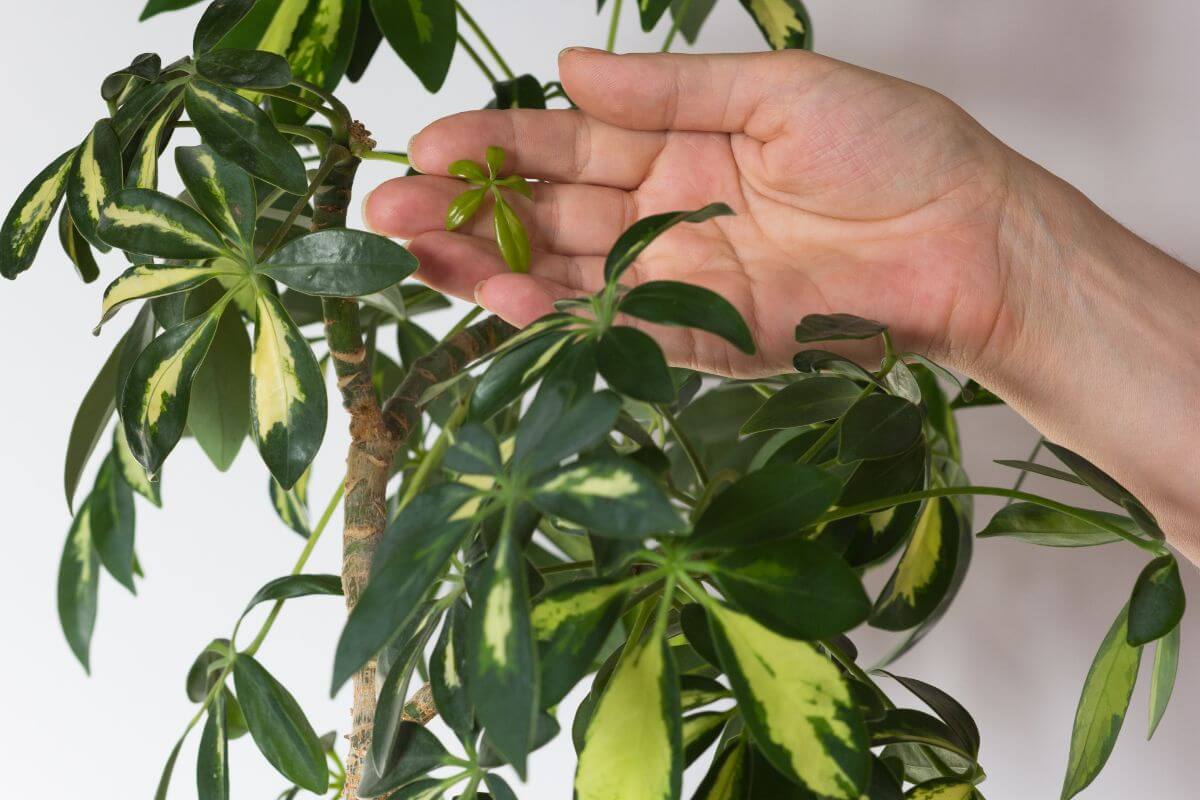
The schefflera arboricola, aka umbrella plant, is recognizable through the touch of color on its leaves. They are also referred to by the variegated varieties of the plant: Green Gold, Gold Capella, and, Compacta.
The schefflera is a tropical plant that’s native to warm, tropical climates in areas like; New Guinea, Australia, Taiwan, and parts of China. They thrive in warmer climates when grown outside, so many gardeners prefer to cultivate them as houseplants.
Larger versions of umbrella plants are often used as shade trees, while smaller plants are considered a good luck charm.
It is especially revered in China, where they see it as a symbol of wealth that invites good energy into the home or as an office plant. The leaves look like curved fingers that form a cup shape mimicking a hand held out ready to receive something, thus the association with wealth.
In contrast, other Eastern religious groups see the leaf cluster arrangement as a symbol of ordered and methodical energy. One thing everyone agrees on is the plant is beautiful, and with the right care it can thrive.
Schefflera Care Guide
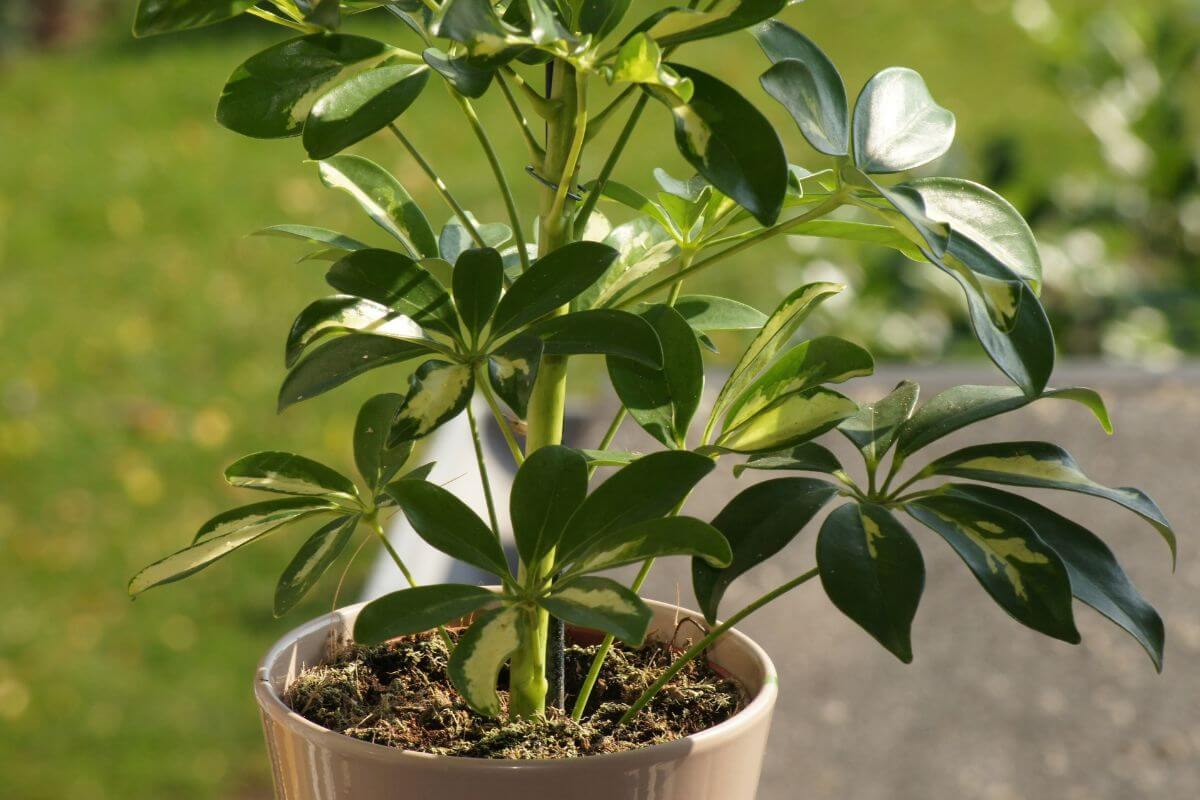
Soil for the Schefflera
The most important thing you need to know when it comes to growing the schefflera arboricola is that it requires well-draining soil.
A good potting mix containing perlite, pomace, or peat-moss is also a good idea. Good drainage is needed because the schefflera hates overwatering, so be sure to empty your drainage tray if there’s excess water. That’ll prevent the plant from being in excess water that can lead to root rot.
Light Preferences for the Schefflera
The Schefflera arboricola can tolerate direct sunlight outdoors, but prefers to have indirect and bright light as an indoor plant. The leaves will burn and discolor when exposed to direct sun.
If you place your plant too close to the window, make sure a sheer curtain is present to protect your plant from accidental sunburn.If you can’t avoid this, move it to a darker area after 3 to 4 hours of sun exposure every day.
If you’re having trouble giving it the bright, indirect light, you may consider buying a 75-watt grow light online to point at the plant.
Watering the Schefflera
Water each week during the summer months and less frequently in the winter months when it grows more slowly. Let your soil dry out before watering again
If you notice brown spots appearing on the leaves, then you’re probably overwatering. You might want to reduce how much water you use until these symptoms go away.
Scheffleras don’t need to be fertilized regularly, but a diluted fertilizer once a month in warm weather will do it well.
Wipe the leaves with a sponge or damp cloth when they start to get dusty. Dust prevents proper water absorption by the leaves.
Temperature for the Schefflera
You should keep your schefflera indoors between 65°F – 80° F year round. If you live somewhere cold, keep it above 60°F or it will die when exposed long enough. Leaves will start dropping if it’s too cold.
Keep it away from cold window and door drafts, as well as air conditioning and heating vents.
Humidity Levels for the Scheffler
Keep humidity levels around 50% throughout the entire year. Too high humidity causes mold growth which leads to rotting roots.
Indoor Growth for the Schefflera
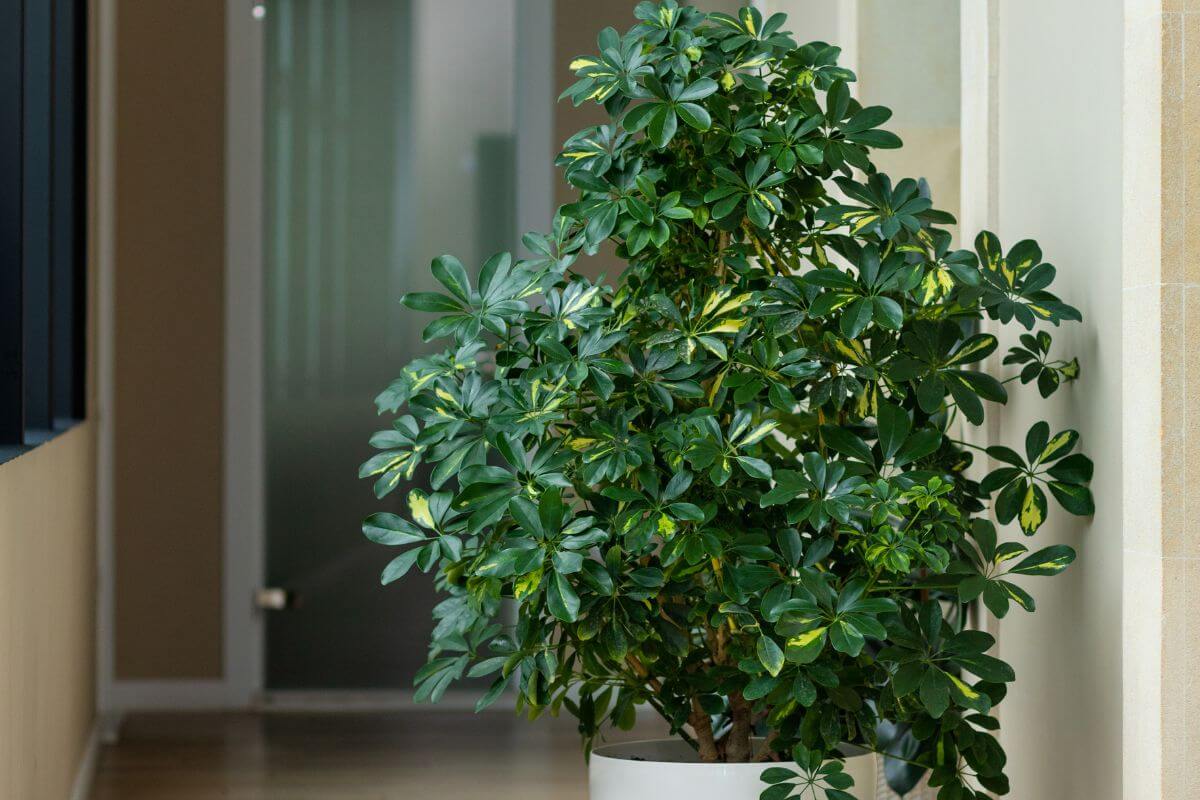
The schefflera can grow up to 25 feet tall outside in the ideal climate, while other species members can even grow up to 80 feet.
When grown indoors, it can grow anywhere from 4 to 6 feet tall and 2 to 3 feet wide as a broad-leaved evergreen shrub. It can grow into a large indoor shrub, but can easily fit most spaces.
The schefflera is a fast grower when outside, but it’s a slower grower indoors. Once it’s a foot tall, it will take approximately 5 to 6 years to reach its full height.
Pruning the Schefflera
The umbrella plant will start to spread its leaves in no time. Scheffleras are known to grow leggy when they aren’t getting enough light or nutrients, requiring its owner to regularly prune the plant.
To do this, you will need to gently cut off the tops of the tallest stalks by about 2.5cm (around an inch). This should encourage new growth and help keep the plants healthy.
You can also remove any dead branches that appear throughout the year. If you see yellowish areas around the base of the plant, you could try removing them. They usually indicate some kind of fungal infection.
Propagating the Schefflera
You can make new umbrella plants by clipping the stem at the base of the plant using a clean pair of shears. Dip the clipped end in rooting hormone, then put the plant in potting soil in a separate container.
Place the pot in bright indirect light, covered with a clear plastic bag to maintain humidity and help speed root growth.
Repotting the Schefflera
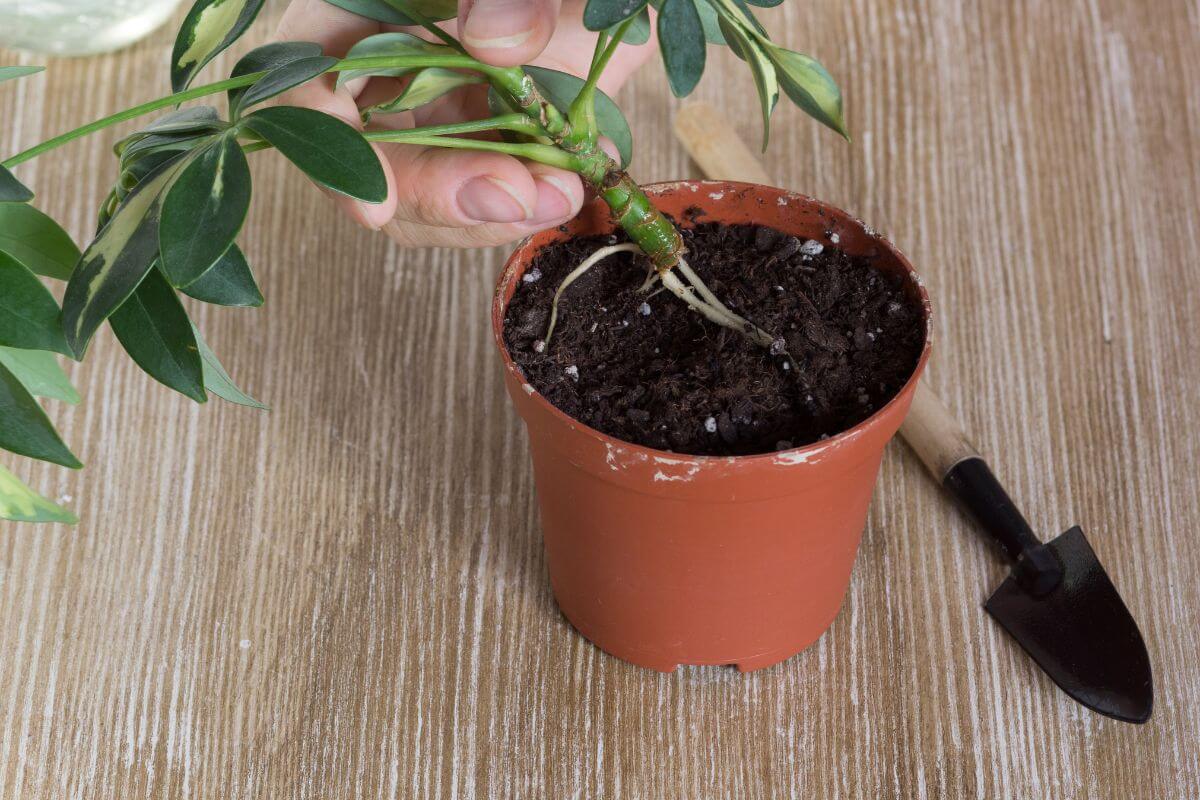
Umbrella plants should be repotted once a year, preferably in the spring. A year is enough time for the schefflera to grow into the current pot it’s in.
You will know your schefflera is ready to be repotted when you see roots growing at the edges of the pot, drainage holes, or emerging out of the top of the soil.
The new pot should be a size larger than your current one. It will give the plant enough room to spread new roots and help it feel a little crowded, as it loves to do.
Common Problems for the Schefflera
Although the schefflera is one of the easiest indoor houseplants to care for, there are a few common problems you should always be on the lookout for.
Pests
The schefflera isn’t prone to pest infestations. Usually, if your plant is bothered by pests, it is under stress from overwatering or minimal light. If not properly supervised, the pests that can attack the schefflera include: spider mites and mealy bugs.
Spider mites leave web deposits under the leaves, their presence is signaled by tiny white spots on the leaf. Mealybugs feed on the plant and turn the leaves yellow, often attracting ants. If not monitored, the plant will surely die.
You can wipe down the plant with a soap water solution with the soap to water ratio being 1:3. Rubbing alcohol is also known to help with mealy bugs. Wipe the top of the leaf and under it, then all through the stem of the plant, since mealy bugs are known to spread wide and are easy to miss.
Neem oil is also another common way of treating pests; you will need to wipe any affected areas with the oil.
Root Rot
This is one of the common causes of the plant’s death that results from overwatering. Your umbrella plant is more likely to suffer from a root rot problem than a pest infestation. However, it is always wise to monitor for both.
The schefflera doesn’t usually get very thirsty, so watering once a week or when the top of the soil is completely dry is the best thing to do.
If it does get root rot, you’ll want to remove the rotting roots and repot the schefflera in fresh soil.
Leggy Growth
Once in a while, you will notice that your schefflera is growing too bushy and thus begins to lean a bit. This is usually a sign that it’s not receiving enough nutrients. It would be ideal for pruning to be done at this stage.
Shedding Leaves
Sometimes the schefflera will start shedding leaves randomly. This is a sign of a bigger problem, usually an indication of overwatering or underwatering.
Care Tips for Growing the Schefflera
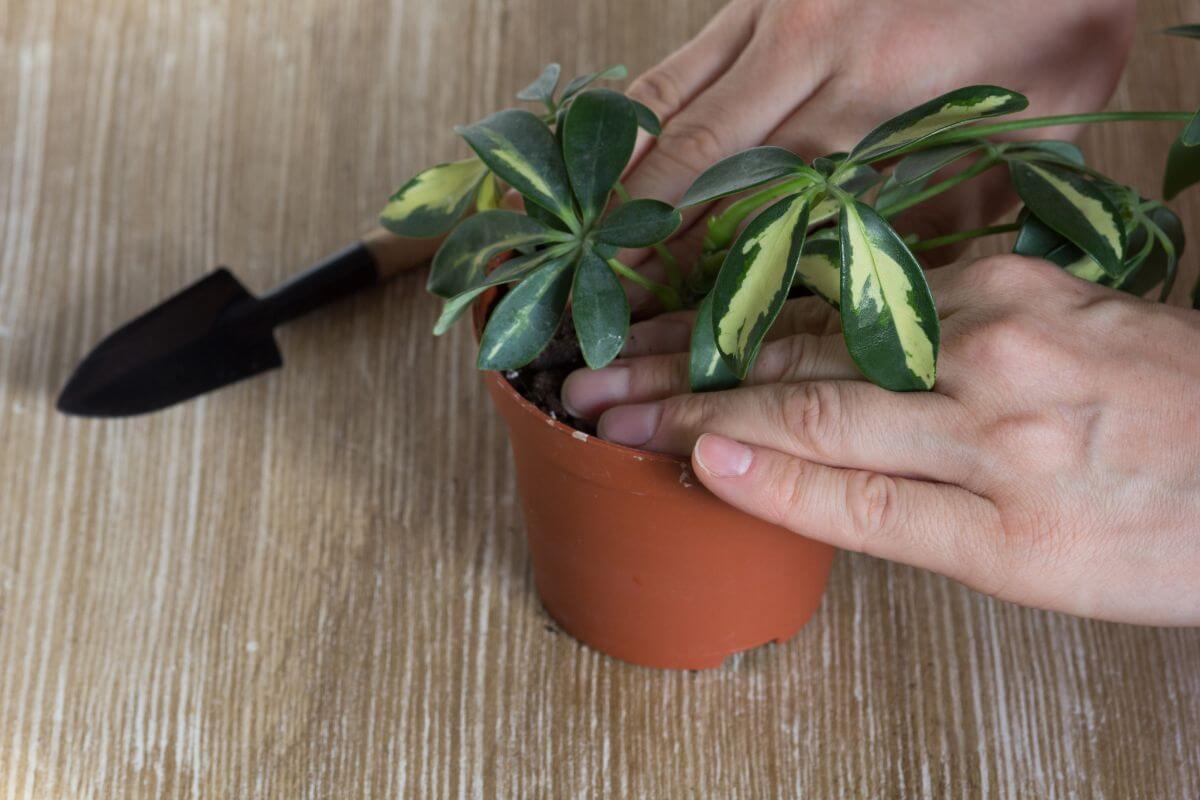
As a schefflera arboricola houseplant owner, you’re going to need a few tips to help you achieve healthy growth.
- Thick stems save lives – When buying your umbrella plant, ensure you pick one with a thick stem as this means it can transport nutrients efficiently to the leaves.
- Massive root system – Your plant needs to have a massive root system as this signals it will thrive.
- White leaves – Variegated white leaves are a sign of healthy growth. Avoid any black leaves as these signal root rot. Brown leaves indicate too much light exposure, while yellow leaves signal underwatering and overwatering.
- Leaf inspection – Carry out a thorough leaf inspection on the top and under the leaf to look for spider mites or mealybugs, and any darkened spots.
- Don’t rush to repot – Ask your seller for advice on repotting if buying from a market. Usually, it is advised to let your plant sit in the pot you bought it for 4 to 5 months before repotting it. Repotting should also be done once a year in a pot that’s one size larger than the previous vessel.
- Stunted growth – Scheffleras are known for their rapid growth. If you notice that your plant isn’t producing any new stems after a long time, this may indicate that it has outgrown its current pot and needs to be re-potted.
- When to water – Dip your finger into the soil to feel the soil’s moisture before adding water. If your finger is dry all the way, it means the plant is thirsty. If you feel a bit of moisture, it would be advisable to wait a few more days before watering.
Pros and Cons of the Schefflera
One of the best things about having a schefflera in your home is that it will be a certain statement piece and conversation starter. Aside from making other plants green with envy, it will also add to your joy every time you see it standing tall and beautiful in your living room.
It’s exciting to see how much the Gold Capella changes when the touch of light green tints the dark green leaves or when tiny stems continue to sprout.
The cons that come with growing a schefflera would be at zero if it weren’t for how quickly it can get bushy and need pruning. It usually gets leggy when the pot it’s in is too small or the plant isn’t receiving enough light and nutrients.
Aside from getting leggy stalks, it might flop over because it’s getting too heavy or start to produce leaves only at the tips. However, if you catch it early and prune correctly, these problems can be easily solved.
Another negative is that the schefflera is poisonous to cats and dogs, so pet owners will need to make note of that before purchasing.
Is Owning a Schefflera Worth it?
The answer is yes in bold. You will never regret your decision of owning a schefflera arboricola once you do.
Maintenance is easy, so only plant care basics are needed. It’s one of those houseplants that adds to your life and doesn’t take away from it.
All you need to do is worry about the placement of the umbrella plant, consistent watering, and then everything else takes care of itself.
If you’re looking for other houseplants to fill your home, here are other popular plants:
- Spider Plant Complete Guide
- Snake Plant Complete Guide
- Dumb Cane (Dieffenbachia) Complete Guide
- Jade Plant Complete Guide
Schefflera Plant Care FAQs
How tall do Schefflera arboricola plants grow?
The Schefflera arboricola can grow 80 feet high when growing outdoors in its natural habitat. When grown indoors, it will grow 4 to 6 feet tall.
How much light do umbrella plants need?
Umbrella plants thrive with bright, indirect sunlight indoors and bright, direct sunlight outdoors.
Is the schefflera plant toxic to cats and dogs?
Yes, schefflera plants are poisonous to cats and dogs. Don’t allow your pets to chew or ingest any parts of the plant. If they do, call a veterinarian immediately.
Can I mist my Schefflera arboricola?
Yes, the arboricola can be misted. However, be careful with the frequency as the plant doesn’t like to have moisture sitting on the leaves as it promotes pests, fungal infections, and diseases.
Why is my Schefflera plant losing its leaves?
If your schefflera is losing leaves, there may be something wrong with the roots. That could be due to overwater or even underwatering. That could also be a sign of an infected plant, so check for pests or disease.
Is the schefflera an indoor plant?
The schefflera is an indoor plant that can be found in most homes. It has small leaves that are usually green on top and white underneath. It can also be an outdoor plant that will grow faster and larger.
How long do schefflera plants live?
Schefflera plants can live for up to 20-30 years when grown indoors. When outdoors in its native tropical evnironment, it can live for more than 100 years.
Does a Schefflera bloom?
Most schefflera plants don’t bloom, but the ones that do are usually grown outdoors. It’s rarer for the plant to bloom indoors. The umbrella plant will bloom in the early spring with white or pink flowers.


